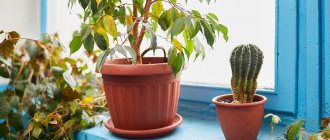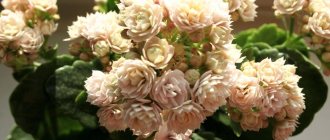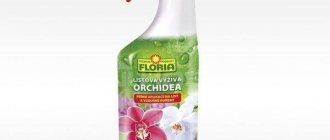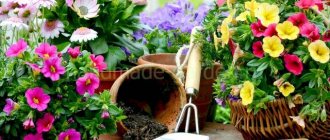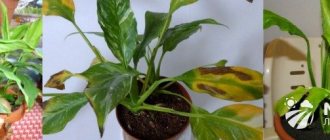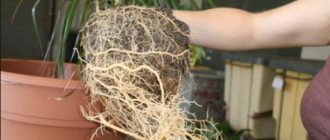How and why to wipe the leaves of indoor plants?
- If plants with dense leaves in the form of ficuses, dieffenbachias, crotons , etc. “live” in pots on your windowsills, then their leaves can be given a matte shine using polishes.
- But yucca, dracaena, clivia and other similar plants are not worth the risk. Rubbing the leaves this way will make them hurt.
- You can only polish already formed plant leaves. For young people who have just recently started, this procedure is contraindicated.
- You can wipe the leaves of indoor plants to make them shine only on already formed leaves . You can’t touch the back side - it’s harmful for them.
- The leaves are wiped not only to give them a waxy-matte beauty, but also to prevent parasites from appearing on the plants, and to remove dust deposits.
The leaves will shine
Drainage
Drainage in pots is necessary to drain excess water, and it also allows the plant to breathe. If the flower is constantly in wet soil, then it may die - the roots will begin to rot.
The advantage of wet wipes is that they are made of synthetic material that does not rot or decompose like paper. It takes them several years to completely dissolve! This is another reason not to throw away used napkins, but to use them again.
This way, the roots will be protected. In addition, the product absorbs perfectly and retains moisture for a long time. You can use both special ones for plants and children’s ones. It is important that they are dry.
You need to remove them from the packaging and air dry them for 5-6 days. Place it tightly in the bottom of the pot, in a layer of up to 10 cm. Then fill it with soil. When you want to replant the plants, the drainage material will be easily separated from the roots. If you buy expanded clay or foam plastic, replanting can be difficult; the roots are tightly intertwined with the drainage material.
Store-bought leaf wipes
- In specialized stores, you can choose from an abundance of products for your plants a polish or spray , the properties of which you can ask your sales consultant.
- Among the advantages of store-bought products: they are effective, quickly give the leaves an amazing shine, and have a beneficial effect on the development of plants.
- Among the disadvantages: possible toxicity that accumulates in plants; Besides, store-bought polishes are not cheap.
Purchased product
How to use purchased polishes and sprays for wiping leaves:
- First of all, you need to carefully study the instructions that are given on each package of industrial products. Usually they are either first sprayed onto the fabric, or done directly onto the leaf itself, and then rubbed with a soft cloth until all the leaves begin to shine.
- Immediately after you have processed all the plants you planned, be sure to ventilate the room in which you worked. When carrying out the treatment, use protective equipment (goggles and a mask), and upon completion of the procedure, take a shower and change clothes.
Washing leaves
It is very convenient to use wet wipes to care for large leaves. This helps to quickly remove dust without injuring the flower, because it is a very thin material that will not harm. The leaf begins to breathe after such cleaning. The main thing is not to buy alcohol wipes (disinfectants).
Experts are against using sponges or sponges - we think they are very soft, but in fact they can harm the top layer, gradually erasing it. As a result, the leaves dry out, become scratched, and after a while they begin to turn yellow and fall off.
Gardening stores sell special wet wipes for cleaning and polishing leaves - this is an ideal option. They are cheap - about 50 rubles for a pack of 20-30 pieces. By the way, the composition on the packaging is not much different from ordinary ones. Gives a pleasant shine to the leaves.
If you don’t have these on hand, then it’s better to use wipes for newborns - no aggressive chemicals or alcohol. This is a very gentle lotion that cleanses and maintains normal pH.
Use one to wipe several leaves, don't press too hard! The leaf should not be wet after such care, otherwise it will not be able to breathe. It should be used no more than once every 2 weeks.
How to wipe the leaves of indoor plants for shine: a DIY remedy at home
How to wipe the leaves of indoor plants to make them shine? You can wipe the leaves of home flowers with polish made at home. We will list you the means that are most effective and harmless.
- You need to mix one part beer (it must be non-alcoholic ) with two parts water. Tested: beer is great for wiping plant leaves and does not harm them. But don't forget to dilute it with water.
- By rubbing the leaves with succinic acid , you will not only give it gloss, but also have a healing effect. To wipe the leaves, you will need to dilute one tablet of succinic acid in 150 ml of water, moisten a soft cloth in this mixture and wipe them until they shine.
- castor oil , undiluted with water , and rub the leaves with it. Castor oil produces a healing effect on the plant.
- Using a silicone brush, apply crushed egg yolk , and then rub using a paper towel - after this procedure the plant will be filled with shine. But in the summer it is undesirable to use egg yolk, since under the influence of heat it will emit a specific smell that insects will flock to.
- Mix one part water and two parts milk , soak a sponge in the mixture and wipe the flower leaves with it. The shine from this product is not as active as from others, but it works and, moreover, is completely harmless to plants.
- You can also wipe orchid leaves with a regular banana peel. Mash the inner side of the peel in your hand and rub it on the leaves of the indoor plant. After rubbing with the peel, particles will remain on the leaves - they will need to be wiped off with a soft cloth.
- You can take one part citric acid, two parts glycerin and dilute with a small amount of water. Orchid leaves will shine when rubbed with this mixture, but glycerin is not the best remedy for plants.
Leaf care
How to care for leaves
Healthy plants always look beautiful. And for this they need to be looked after regularly. It is especially important to keep the leaves clean . Dust settles on them, like on any other objects in the apartment, which prevents the penetration of sunlight to photosynthetic cells. This means that the plant accumulates less nutrients, its development slows down, flowering is delayed, and resistance to diseases, pests and adverse external factors decreases. And vice versa, the faster photosynthesis occurs in the leaves, the healthier the plants, the more actively they store nutrients and the easier it is to endure wintering.
How to care for leaves
In addition to dust, plants often suffer from salt deposits after spraying with hard water. White spots spoil the appearance of leaves, clog stomata, and block sunlight. Water deposits also need to be removed.
The easiest way to clean is to wash the plants in a warm shower , shake off any drops and let them dry in partial shade. In open sun, wet leaves can get burned.
The water temperature for bathing plants should be within + 22-40 degrees, preferably + 30-35 degrees. Water that is too hot or cold can damage leaves and young shoots.
In case of severe contamination - greasy deposits from gas stoves, excretion of aphids or scale insects, sooty deposits - the leaves are sprayed with a soap solution, then washed with water in the shower. A soap solution is prepared from washing powder (5 g per 1 liter of water) or soap - laundry or any without dyes - 10 g per 1 liter of water.
Tall plants are more difficult to wash. However, savvy gardeners will always find a way to do this. Around a large flowerpot, the floor, and if necessary, the walls, are covered with plastic film. Several layers of old newspapers are placed on the floor on the film. Then they stand on a stool and wash off the dust from a watering can in a thin stream. Small indoor flowers can be washed in a bucket of warm water. Plastic wrap is wrapped around the top of the pot around the base of the plant to protect the soil from getting wet and spilling out. Then they clasp the top of the pot with their palm, passing the trunk or rosette of leaves between their fingers, turn it over and dip the above-ground part of the plant into water several times.
to clean plants from dust once a month in winter and once every two weeks the rest of the time, more often if necessary.
You can blow off the dust with a vacuum cleaner or brush it off with a brush, soft brush, dry or damp cloth. However, these cleaning methods, unlike the shower, are not suitable for all plants and are chosen individually for each type. You can blow off dust or remove it with a soft brush from pubescent or thorny plants, such as Saintpaulias, cacti, and some euphorbias. You can wipe the leaves with a soft cloth on anthuriums, hippeastrums, camellias, clivias, rubber ficus, strelitzia, citrus fruits, and epiphyllums.
To keep your plants healthy, you also need to get rid of diseased, dry, brown or yellowed leaves. Using sharp scissors, carefully trim off any dry brown tips or edges.
Harmful procedures
Recently, it has become fashionable to rub leaves with oil solutions to give them shine. These procedures are harmful to plants. Polishes or oils clog the stomata of leaves through which they breathe, regulate the temperature inside the leaf cells, evaporate water, phytoncides and other substances that protect plants from attacks by pests, diseases and other unfavorable factors. Leaves with clogged stomata quickly fall off. Therefore, you should think about what is more important - the health of the flower or temporary beauty.
Systematic care of leaves will help avoid pests and many diseases. You will always detect signs of plant damage in a timely manner and take timely measures to eliminate them. During the initial period of plant colonization by aphids, scale insects or mites, showering is no less effective than using pesticides.
On a note:
Useful tips for flower growers
What is the best way not to wipe the leaves of indoor plants?
The best way not to wipe the leaves of indoor plants:
- When beeswax , the leaves lose their ability to breathe. In addition, the leaves develop an uneven shine and become covered with wax pellets. Wax can also clog the mouth of the leaves.
- When using alcoholic beer in the form of a polish, the plant begins to hurt, becoming covered in spots, as if from a sunburn.
- When using alcohol (ethanol), the leaf plates are damaged; Due to overdrying, the leaves become covered with whitish or brown spots.
- Glycerin clogs the mouths of the leaves, although it gives off an excellent shine. But it is better to use castor oil or succinic acid, which are very beneficial for plants.
We will also tell you:
- Do I need to tie garlic leaves in a knot and when?
- Why do ficus leaves turn yellow and fall off?
- How to quickly dry leaves for a herbarium
- Tomato leaves curl in a greenhouse
- The leaves and stem of the planted cabbage seedlings have turned blue
Feeding flowering and evergreen plants
The flowering of most indoor crops occurs in the warm season - the active growing season. But some species bloom in winter - these include, for example, Decembrist, cyclamen, poinsettia, phalaenopsis. Feeding them with a solution of complex fertilizer for flowering plants (organomineral complex fertilizer Good Strength or liquid fertilizer for indoor plants Bona Forte) will help them maintain their strength.
It is recommended to fertilize in winter using half the dose indicated in the instructions. You can feed plants in the flowering stage once every two weeks.
Decorative leafy crops that are in a dormant period do not need to be fed in winter. An exception can be made if you began to illuminate the plants and saw young leaves on them. This means that your pets are entering a period of active growth and feeding can be resumed as early as January.
- How to feed indoor plants - choosing the ideal fertilizers for flowers on the windowsill
Do you want your plants to look healthy all year round? Then create the right feeding regimen for them!

